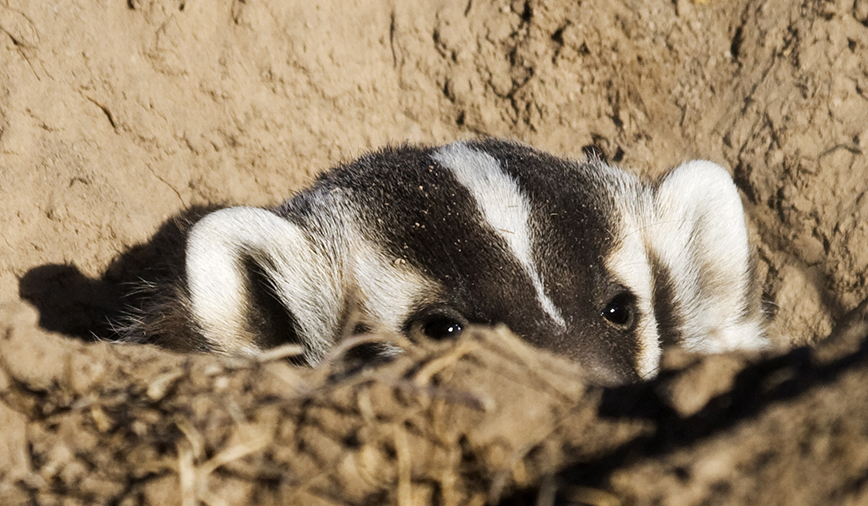At the end of last week’s column, the reputation of a certain local naturalist was in tatters. She’d mistaken a dead raccoon, one of our area’s most common roadkills, for a badger, a mammal that is rarely seen in Kane County. Little did she know, though, that badgers were alive and well—and reproducing, even, just a few miles away.
She…
Okay, let’s drop the pretenses. Yeah, it was me. I was the nature professional who, through a combination of haste, optimism and poor judgement, thought a roadkill raccoon was a belly-up badger. In the process I led several other folks astray and created the false hope that Taxidea taxus, the American badger, was present, and numerous enough to get hit by cars, right here in Kane County.
As the weeks went by, I endured a fair amount of ribbing from friends and colleagues. One buddy even came up with a new species, Coonicus ottoii, the ring-tailed badger. With my head hung in shame, I prepared to turn in my Naturalist Card and vowed to never speak of badgers again.
But then along came Hampshire resident Karen Bogacz.
Karen and I met at Campton Hills’ National Night Out on August 3 when she stopped by the Hickory Knolls Discovery Center table. We had a lovely time chatting on that warm summer night, I’m sure, but I really don’t remember many details of our conversation. I was too busy trying to suppress the urge to whoop, cheer, holler, scream and jump for joy. Because Karen, with a slight smile and, I swear, a twinkle in her eye, dispelled all the shame I’d been carrying with one magical sentence:
“I have badgers behind my house.”
Badgers. The mammal that had haunted me; visions of which had kept me up at night.
Not only did Karen describe what she’d seen but, better still, she had photos. Gorgeous photos of a real, honest-to-goodness badger that was alive and well—and reproducing, even, right in her own backyard.
Did I mention I was overjoyed?
Now I know badgers don’t have the widespread appeal that certain other mammals possess. Sure they’re ornery (“solitary and defensive” in naturalist-speak) and well-armed, with 34 sharp teeth and front claws that measure almost 2 inches in length. But they consume tremendous amounts of rodents, insects and carrion – the types of things that would get out of hand without some means of control. And the burrows they excavate – sometimes at a rate of one a day, in search of prey – become homes for many types of wildlife less well-equipped for digging.
Nomadic by nature, badgers really don’t stay in one place for very long—unless they’re rearing young. And that’s what made Karen’s badger extra cool. It had excavated a natal den, and raised three pups.
An adult female, three offspring and presumably a male somewhere in the vicinity adds up to a fair amount of badgers in northwestern Kane County. The pups matured and, Karen later reported, were nowhere to be seen by mid-August. Each had moved on, or dispersed, an action that is key to badger survival. These hefty critters need a fairly large territory for their size, as much as 3 or 4 square miles per individual.
So why don’t we see more badgers in our area? Habitat loss is probably the main reason. And unlike raccoons and skunks, which are perfectly at home around your home, badgers prefer open space – something we don’t have a lot of anymore. They’re not social either, so other than a female with young you’re unlikely to see them in groups.
Interestingly enough, though, I hear about badgers maybe two or three times a year, mostly from people who own or live near large expanses of open space. Not prairies so much as old fields and pastures. In fact, long-time Good Natured readers may recall the time, in 2010, when our coworker Denis Kania spotted what he at first thought was a dead raccoon along Red Gate Road, east of Randall—an area home to horse farms, and pastures.
Denis, who is not in any danger of having his Naturalist Card revoked, was pretty sure he’d seen white stripes on the head of the unfortunate animal. He circled back and, sure enough, found a deceased male badger with trauma, likely from a car, to one side of its body.
Today, six years later, that badger is still in our Hickory Knolls freezer. A might freezer burned, it still makes appearances as our programming needs dictate. It also serves as our most credible evidence of badgers in Kane County. At least it did, until Karen shared her photos.
Curious about whether badgers are on anyone else’s radar, I contacted Bill Graser, wildlife biologist with the Forest Preserve District of Kane County. He said he and his staff have had a couple of observations this summer, including a dead badger on August 15, not far from Route 47.
The next time you’re out and about, especially in the western part of the county, keep an eye out for stocky, lumbering creatures with distinctive white stripes on the face. Who knows? You just might get to earn your very own Naturalist Card. One with a special Badger Endorsement.
Pam Otto is the manager of nature programs and interpretive services at the Hickory Knolls Discovery Center, a facility of the St. Charles Park District. She can be reached at potto@stcparks.org or 630-513-4346.

